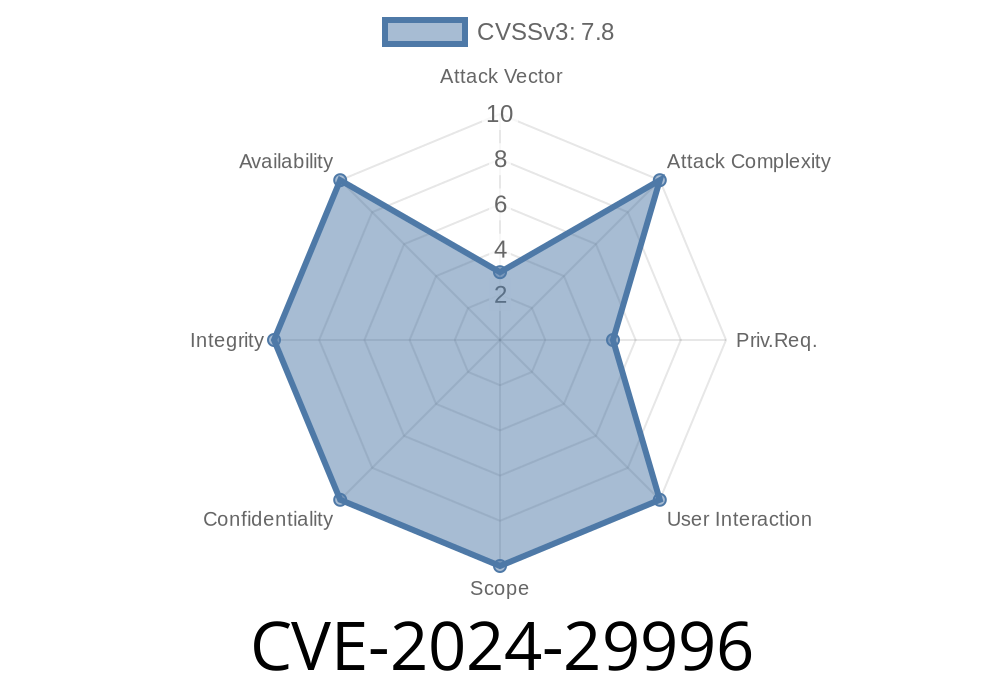CVE-2024-29996 recently broke headlines as a serious security problem in Microsoft Windows systems, specifically targeting the Common Log File System (CLFS) driver. What makes this vulnerability dangerous is that it allows attackers to gain SYSTEM-level privileges on a victim's computer—a classic "elevation of privilege" vulnerability. In this post, we'll break down how CVE-2024-29996 works in simple terms, show a basic exploit snippet, and provide references for anyone curious to dig deeper.
What is the Common Log File System Driver (CLFS)?
The CLFS driver (clfs.sys) is a core Windows component used to manage logs that applications and services generate. Think of it as a high-speed, reliable way for programs to record their activity. Since it's a Windows driver running in kernel mode (which is super-privileged), a bug here can be catastrophic.
What’s the Problem with CVE-2024-29996?
This vulnerability enables attackers to escalate their access from a regular user to the SYSTEM user—the most powerful account on Windows.
The vulnerability is due to improper validation of inputs and buffer handling in clfs.sys.
- An attacker with the ability to run code on the victim machine can exploit this to run code in the kernel.
- Result: attacker can install programs, view/change/delete data, or create new admin accounts.
Below is a simplified view of how a local attacker could abuse the bug
1. Craft Malicious Log File: The attacker creates a specially crafted log file that triggers the bug.
2. Interact With CLFS: Using Windows API calls, the attacker instructs Windows to open and process this malicious log.
3. Trigger Vulnerability: The bug in clfs.sys mishandles the file, and the attacker can write code to gain SYSTEM privileges.
Exploit Pseudocode Example
> WARNING: Ethics first—use your skills only for good. This snippet is for educational purposes.
Here’s a BASIC STRIPPED-DOWN flow showing how an exploit might look in C
#include <windows.h>
#include <stdio.h>
int main() {
HANDLE hLog;
// Step 1: Create a malicious CLFS log file (details omitted for simplicity)
// Step 2: Call CreateLogFile to open log (hLog)
hLog = CreateFileW(L"\\??\\C:\\Temp\\evil.log",
GENERIC_READ | GENERIC_WRITE,
, NULL, CREATE_ALWAYS, FILE_ATTRIBUTE_NORMAL, NULL);
if (hLog == INVALID_HANDLE_VALUE) {
printf("Failed to open log file.\n");
return 1;
}
// Step 3: Use DeviceIoControl or CLFS API to interact with CLFS driver
// This could exploit the vulnerability
// ... (exploit code here)
CloseHandle(hLog);
return ;
}
Again, the real exploit is highly technical and involves deep knowledge of Windows internals—this is a conceptual example.
Is There a Patch?
Yes! Microsoft released a security update.
If you’re running Windows, make sure you update as soon as possible. Monthly Patch Tuesday updates cover CVE-2024-29996.
- Microsoft Security Advisory for CVE-2024-29996
Who is At Risk?
- Any unpatched Windows 10/11 or Windows Server system
Monitor for Unusual Activity: Use endpoint security tools to detect suspicious behavior.
## Further Reading / References
- Microsoft Security Guidance: CVE-2024-29996
- CLFS.sys Driver Analysis
- Windows Kernel Exploitation Fundamentals
Closing Notes
CVE-2024-29996 is a big reminder of how local bugs in powerful Windows drivers can give attackers major control. The most important action is patching and staying cautious about what you run on your machine.
Timeline
Published on: 05/14/2024 17:16:19 UTC
Last modified on: 06/19/2024 20:58:19 UTC
